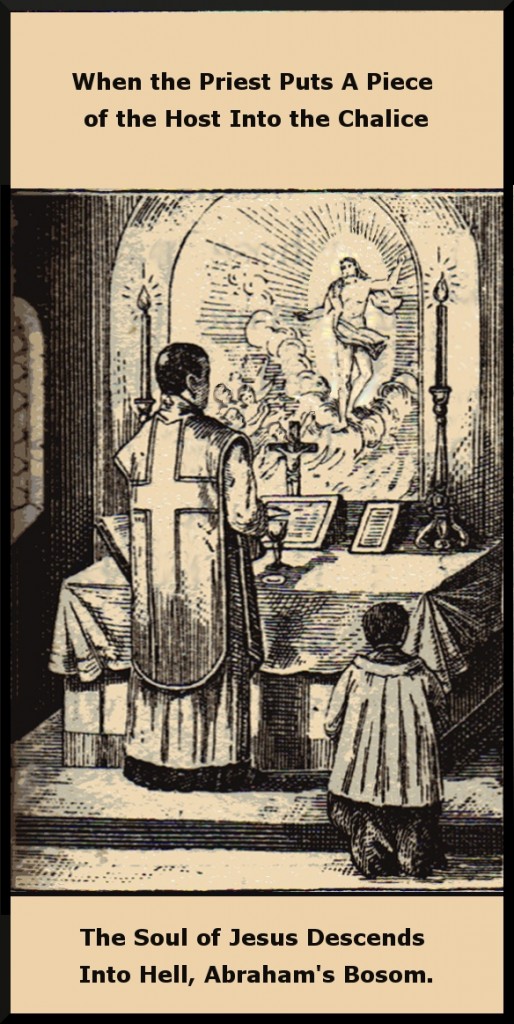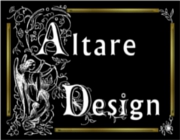 With the small piece of the Host, the priest makes the sign of the cross three times over the chalice, then drops It into the Precious Blood. This mingling symbolically denotes that the entire Body, Blood, soul and divinity of Christ is contained under both species: “…from the fact that the consecrated elements are united with each other by mingling, it is thereby symbolically expressed that in reality on the altar, the Body is not without the Blood, and the Blood not without the Body, but under each species the whole Christ is present as one sacrificial gift and one sacrificial food.” – Gihr.
With the small piece of the Host, the priest makes the sign of the cross three times over the chalice, then drops It into the Precious Blood. This mingling symbolically denotes that the entire Body, Blood, soul and divinity of Christ is contained under both species: “…from the fact that the consecrated elements are united with each other by mingling, it is thereby symbolically expressed that in reality on the altar, the Body is not without the Blood, and the Blood not without the Body, but under each species the whole Christ is present as one sacrificial gift and one sacrificial food.” – Gihr.
As the separate Consecration for each species, together with the fraction of the Host, denote His mystical death, so the mingling of Host with the Precious Blood is a liturgical action that conveys vivification by a reunion of blood to the body. Our Eucharistic Lord is the Lamb of the Apocalypse, slain, yet Who lives and reigns! Quoting Gihr again, “the mystical union of the Body and Blood of Christ by this mingling symbolizes His glorious resurrection in which His Body and Blood were again united and vivified.”
With regard to the three crosses made over the chalice, according to St. Thomas Aquinas, they signify the three days that our Lord was entombed. (The chalice represents the tomb, the paten, the stone that sealed it.)
In her visions, Blessed Anne Catherine Emmerich said that upon Our Lord’s descent into Hell she saw “a dark spot in which Adam and Eve were standing [and that] they prostrated and adored Him in perfect ecstasy of joy.” Also there to greet Him with raptures of joy and gratitude were the Patriarchs, the Good thief, Moses, the Judges, Joachim and Anna, Joseph, John the Baptist, all the just who were awaiting their redemption in that prison of banishment and darkness.
She also said, “Our Lord, by descending into Hell, planted in the spiritual garden of the Church, a mysterious tree, the fruits of which, – namely His merits – are destined for the constant relief of the poor souls in Purgatory. The Church militant must cultivate the tree and gather its fruit, in order to present them to that suffering portion of the Church which can do nothing for itself.”
Prayer: “Lord Jesus Christ, who, after Thy glorious victory over the devil, didst descend into Limbo, and thence liberate the souls patiently awaiting their ransom; extend, I beseech Thee, the virtues of Thy most precious Blood and Passion to the faithful in Purgatory, that they may soon arrive at eternal bliss with Thee. Amen.”
++++++++++++++++++++++++++++++++++++++++++++
In the TLM, the priest prays, “May this commingling and consecrating..”. Note the use of the two words, “commingling” and “consecrating” by which there is signified two actions occurring at this point in the Mass, not just the commingling. Gihr states (Pg 712) that the “consecratio” of the Body and Blood of our Lord at the mingling “imparts to them a holy and a mystical signification.” He says that the Species, are “raised unto and made a symbol of a holy mystery….for Christ appears therein as the resuscitated, living Pasch, and as such is represented or offered to God….Christ’s glorious sacrificial Body is consecrated and dedicated to God for us.”
In the N.O the word “consecration” was eliminated. Therefore, there is no intentional consecrating and dedicating of the Eucharistic Lamb as being offered to God specifically for the faithful who are to receive. (The three crosses over the chalice were also abolished.)
Compare:
(TLM) – May this commingling and consecrating of the Body and Blood of Our Lord Jesus Christ avail us who receive it unto life everlasting. Amen.
(N.O.) – May this mingling of the body and blood of our Lord Jesus Christ bring eternal life to us who receive it.



